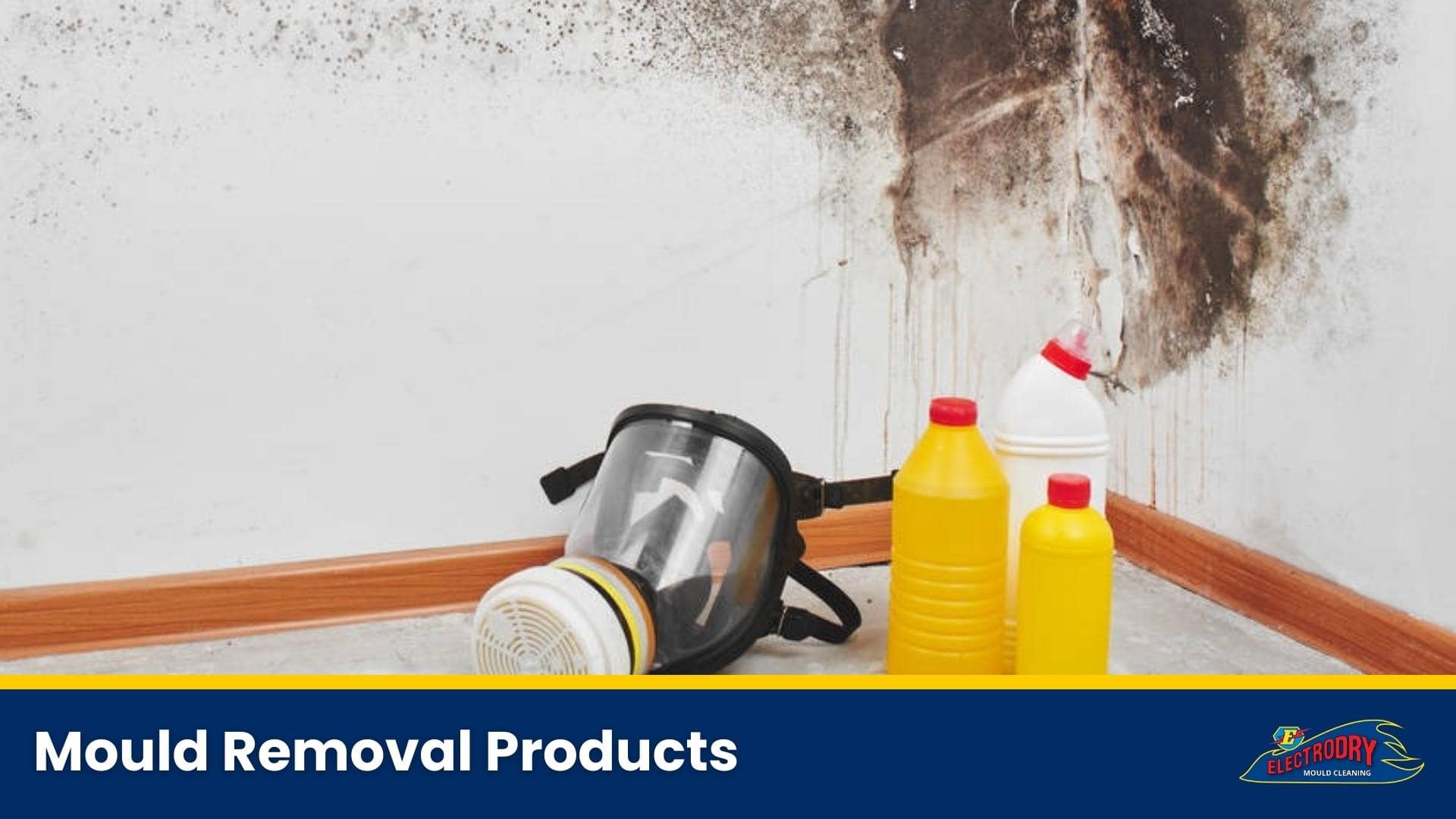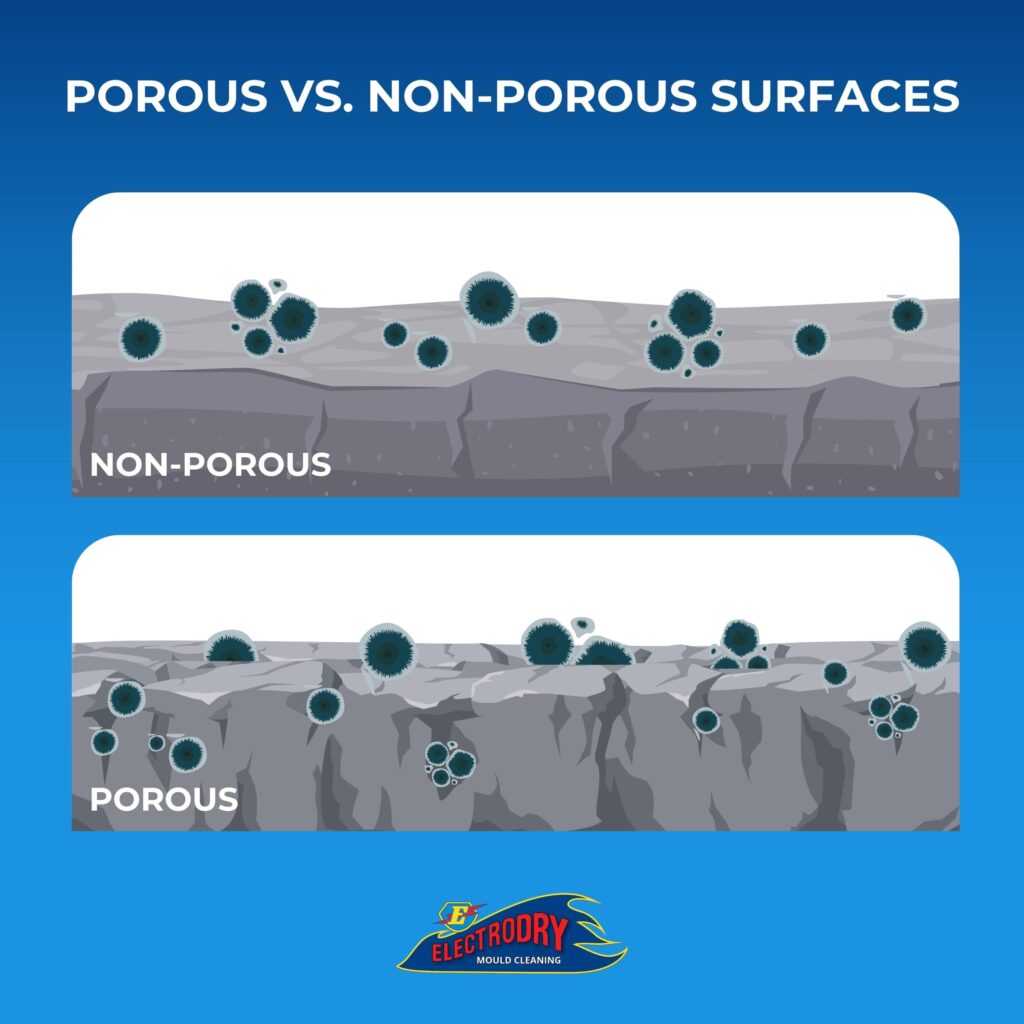Mould Removal Products

Mould can be a persistent and harmful problem in many homes. If you’re dealing with mould growth, you may be wondering what products are available to help with its removal. If left untreated, mould can cause damage to your property and pose health risks.
In this article, we explore the best mould removal products available on the market and techniques that can effectively eliminate mould from your home. Note that mould removal is often also referred to as “mould remediation” or simply “mould cleaning”.
From natural remedies like vinegar, borax, and baking soda to commercial products like bleach and chlorine, we provide a comprehensive guide to help you choose the right mould removal product for your needs.
However, if your mould issue is severe, we strongly suggest getting in touch with professional mould removal in Perth to ensure your and your family’s safety.
Porous vs. Non-Porous Surfaces: Impact on Mould Removal

Non-porous surfaces are solid, compact, resistant to absorption, and do not have pores – tiny holes or spaces that allow liquids or gases to pass through. Porous surfaces, on the other hand, have minute openings or pores and can absorb liquids, gases, or small particles.
We’ve summarised the key differences between mould removal on porous and non-porous surfaces in the table below.
| Porous Surfaces | Non-Porous Surfaces |
Examples | Unsealed wood, wallpaper, fabric, ceiling tiles, drywall, carpet | Vinyl, metal, glass, glazed ceramic, porcelain |
Characteristics | Mould thrives on porous surfaces because they trap moisture | Typically easy to clean because their non-porous surfaces do not absorb or trap dirt |
Effective Cleaning Solutions | White vinegar, borax, bicarb, tea tree oil, hydrogen peroxide, clove oil, steam cleaning | White vinegar, borax, bicarb, bleach, hydrogen peroxide, sugar soap, chlorine, clove oil, Pine O Cleen, Astonish, steam cleaning, caustic soda |
Impact on Mould Removal
The porosity of a surface significantly impacts the selection of mould remediation products and strategies. DIY mould-cleaning strategies must take these properties into account to achieve mould removal goals effectively. Porous surfaces require a more hands-on approach where the product seeps into the material to break down the mould structure.
Best Mould Removal Products
We’ve compiled a list of the best mould removal products available, some of which may even be in your kitchen or bathroom cupboards right now.
Remember that even if you remove all the mould in your house, you’ll need to prevent it from returning. Air out your home as often as possible, use dehumidifiers, and check mould-prone areas regularly. Check out our tips for mould prevention at the end of this article.
White Vinegar
White vinegar is a versatile cleaning staple and an excellent natural mould remover that has been used for centuries. It is a natural, non-toxic, and popular alternative to bleach and can be used on a variety of surfaces.
White vinegar is particularly effective on non-porous surfaces, but can also work well on porous materials. Not only is vinegar effective against mould, but it also works on mildew. Always make sure to dilute white vinegar with water as it can damage certain surfaces.
Borax
Borax is another non-toxic alternative and a potent mould removal product. Although it is less effective as a soap scum remover than vinegar, borax remarkably inhibits mould growth in the long run.
A simple mix of borax and water is a proven DIY mould-cleaning solution for porous surfaces. Borax is a gentler solution compared to other cleaning sprays and doesn’t produce harmful fumes. Remember to spot-test your surface first, as borax can stain some porous surfaces.
Bicarbonate of Soda (Baking Soda)
A classic choice for cleaning and killing mould, bicarb or baking soda is both a mildew remover and an odour neutraliser. Using a damp microfiber cloth and bicarb can lead to effective mould remediation, especially on non-porous surfaces.
Bicarb is an excellent mould-cleaning agent, especially when combined with vinegar. It doesn’t just kill mould, but also absorbs moisture, preventing future mould growth.
Bleach
Bleach (or sodium hypochlorite) is a popular choice for mould cleaning, particularly for white, non-porous surfaces where discolouration is not a worry. Bleach is a strong mould and mildew remover suitable for surfaces like tile and glass, but it will not work effectively on non-porous surfaces like drywall or wood.
Bleach is great for removing mould, however, remember to always follow safety precautions and rinse thoroughly after cleaning and before applying additional mould removal products.
Chlorine
Chlorine is commonly used in mould-cleaning products thanks to its potent disinfecting properties. It’s especially useful in cleaning mould from bathroom tiles and grout cleaners, as well as for preventing mould’s rapid growth.
Chlorine should always be used with care due to its harsh nature. It is most effective on non-porous surfaces.
Clove Oil
As an eco-friendly, natural mould remover, clove oil is particularly effective against black mould. When diluted with water, it can be used as a spray to clean mould off many different surfaces. Clove oil works by disrupting the mould growth process. It will also leave your house smelling amazing thanks to its distinct, aromatic smell.
Sugar Soap
Sugar soap is an excellent mildew, mould, and soap scum remover. It performs remarkable work on non-porous surfaces with accumulated dust, grease, oil, and latex. It easily lifts grime off the surfaces, leading to an overall cleaner area.
Sugar soap does, however, leave behind a thick residue, so it’s best not to use it on wooden surfaces. Spot-test a small area before tackling the entire surface.
Tea Tree Oil
Mould doesn’t stand a chance against tea tree oil. It works effectively to kill mould spores. Although a bit pricey, a little goes a long way.
Tea tree oil has become a crucial component of many mould removal products in Australia, as it works really well against stubborn mould. This natural mould remover has disinfectant and fungicidal/anti-fungal properties, safely killing most types of mould.
Hydrogen Peroxide
Hydrogen peroxide is a potent disinfectant that is highly effective against mould. It can be used on many different surfaces to kill mould, and it’s a much safer alternative to bleach. Water mixed with 3% concentrated hydrogen peroxide can be sprayed onto the mould-affected area.
Note that hydrogen peroxide must be used with care. Do not mix hydrogen peroxide with any other cleaning solutions.
Pine O Cleen
Pine O Cleen’s mould-cleaning prowess is attributable to powerful ingredients like hydrogen peroxide and eucalyptus extract. It can be used as a spray, providing a rapid application solution to address mould problems.
Pine O Cleen is a versatile cleaner that works on many different surfaces and against various types of mould. Plus, it has a pleasant pine scent!
Steam Cleaning
Steam cleaning is a popular choice for DIY mould cleaning, however, this technique will not eliminate all the mould or spores. Steam offers a non-toxic, deep-cleaning process that can help get rid of mould on both porous and non-porous surfaces – the heat from the steam disinfects and eradicates mould, leaving surfaces much cleaner. This is a simple, quick, and effortless way to clean mould, but it’s important to keep in mind that the mould may grow back.
Astonish Mould and Mildew Remover
Astonish is renowned for its efficacy in removing mould and mildew, with no scrubbing needed. Formulated with bleach, it is perfect for use on hard surfaces, plastics, and ceramics. Astonish is thus suitable for use in many areas of the house and can handle even the toughest of mould stains.
Dry Cleaning
Dry cleaning is an alternative for valuable, non-washable items that may suffer from mould. Products like mildew removers and mould removal sprays can be used alongside traditional dry cleaning processes for optimal results. Remember, it is always best to consult a professional before cleaning delicate items.
Caustic Soda
Caustic soda or sodium hydroxide can be used to remove mould from hard surfaces. However, it is highly corrosive and should be used with caution. Always wear gloves and goggles, and avoid direct contact with the skin. Caustic soda is a strong base and can cause chemical burns.
Remember, no matter which mould removal products you choose, always follow the manufacturer’s instructions for the best results. Also, consider seeking professional assistance if the mould problem persists.
Tips for Mould Prevention
- Regular cleaning reduces the chances of having to resort to more serious measures, such as the use of bleach or hydrogen peroxide. Simple actions, such as wiping surfaces dry after use and ensuring proper ventilation, go a long way in ensuring mould doesn’t have a conducive environment to develop. Key areas to clean often include bathrooms, kitchens, and laundry rooms, as these are typically high-moisture areas.
- Mould thrives in moist conditions. By ensuring that your home, particularly vulnerable sites such as bathrooms and kitchens, remain dry, you reduce the risks of mould growth.
- Natural mould removal products are a safer alternative for your family and the environment. It’s a good idea to try natural remedies first and then move on to commercial products or professional services.
You might want a professional’s assistance if your DIY efforts to remove the mould in your home have not been successful. Contact our friendly and professional team at 1300 902 362 or via our contact page.
Mould Removal FAQs
What is the Best Mould Remover?
There are numerous mould-cleaning products available in Australia, but your choice depends on your specific needs and the type of surface you’re cleaning. If you’re facing a severe mould issue, professional-grade cleaners may be necessary. For more surface-level mould, products such as vinegar, bicarb, tea tree oil, or Astonish’s mould remover spray will likely suffice.
Can Laundry Detergents Remove Mould?
Laundry detergents are not typically designed to kill mould. However, laundry products with a bleach base may help in mould remedy. But for cleaning surfaces, it’s better to resort to mould removal products specifically designed for the task.
How to Use Cleaning Sprays for Mould?
For optimal results, spray the mould removal product on the affected area and let it sit for the duration recommended by the manufacturer. After the recommended time has passed, use a warm, damp microfibre cloth to wipe the surface clean. You should also dry the area with a fan, and open windows and doors.
What Should I Do When Mould Affects a Large Area?
If mould has spread to a large part of your home, you should call an expert. To stop mould from spreading, you must act quickly to get rid of it with the help of a professional. Also, knowing how to safely handle dangerous cleaning products like bleach or hydrogen peroxide is important for safety.
